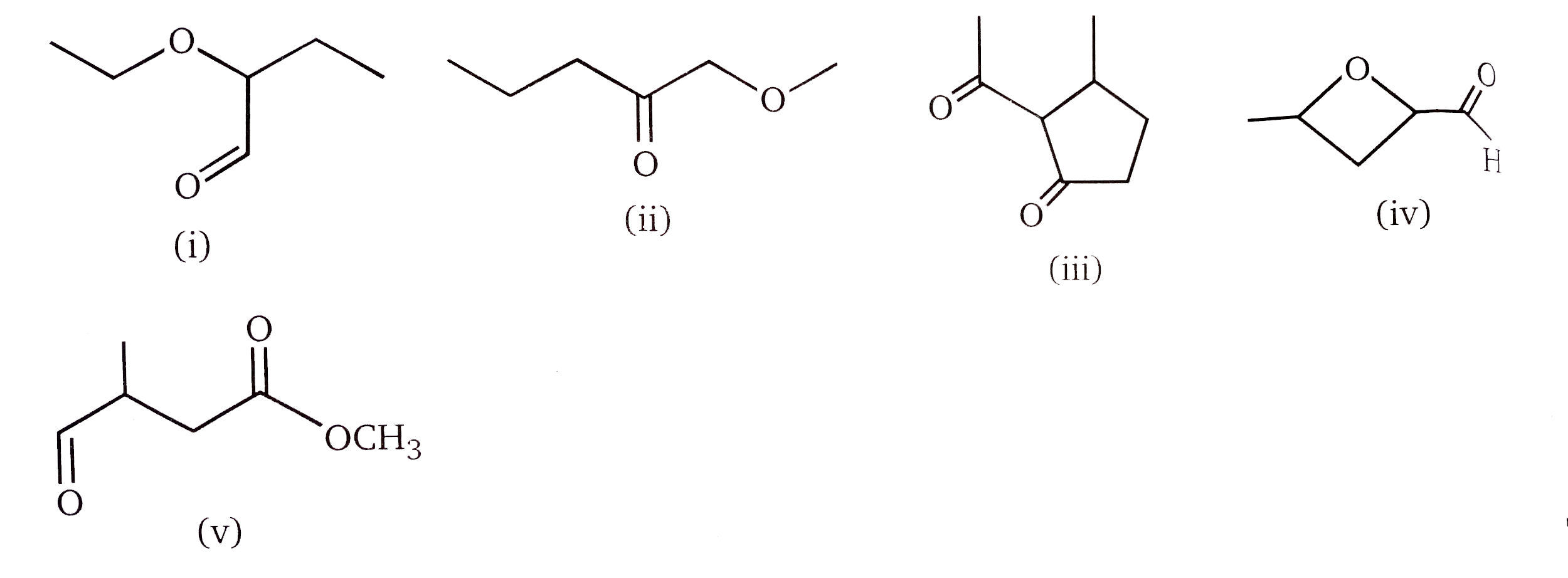Which of the following show glucose has aldehyde group
It gives Tollen's reagent test
It gives Fehling's solution test
It gives Schiff's reagent test
It gives reaction with NaHSO3 and NH3
The correct Answer is:A, B
To determine which of the following tests show that glucose has an aldehyde group, we can analyze the reactions of glucose with specific reagents.
1. Understanding Glucose Structure:
- Glucose is an aldohexose, meaning it contains an aldehyde group (-CHO) at one end of its carbon chain.
2. Identifying the Tests:
- The question refers to two specific tests: the Tollen's test and the Fehling's test. Both tests are used to identify aldehydes.
3. Tollen's Test:
- When glucose reacts with Tollen's reagent (which contains Ag(NH3)2+), it reduces the silver ions to metallic silver, forming a silver mirror. This indicates the presence of an aldehyde group.
- Reaction:
Glucose+Tollen's reagent→Gluconic acid+Ag (silver mirror)+H2O
4. Fehling's Test:
- Similarly, when glucose is treated with Fehling's solution (which contains Cu2+ ions), it reduces the blue copper(II) ions to red copper(I) oxide (Cu2O), indicating the presence of an aldehyde group.
- Reaction:
Glucose+Fehling's solution→Red precipitate (Cu2O)+Gluconic acid
5. Conclusion:
- Since glucose reacts positively with both Tollen's reagent and Fehling's solution, it confirms that glucose has an aldehyde group. Therefore, the correct options are those that refer to these tests.
Final Answer:
- The tests that show glucose has an aldehyde group are Tollen's test and Fehling's test.
- Glucose is an aldohexose, meaning it contains an aldehyde group (-CHO) at one end of its carbon chain.
- The question refers to two specific tests: the Tollen's test and the Fehling's test. Both tests are used to identify aldehydes.
- When glucose reacts with Tollen's reagent (which contains Ag(NH3)2+), it reduces the silver ions to metallic silver, forming a silver mirror. This indicates the presence of an aldehyde group.
- Reaction:
Glucose+Tollen's reagent→Gluconic acid+Ag (silver mirror)+H2O
- Similarly, when glucose is treated with Fehling's solution (which contains Cu2+ ions), it reduces the blue copper(II) ions to red copper(I) oxide (Cu2O), indicating the presence of an aldehyde group.
- Reaction:
Glucose+Fehling's solution→Red precipitate (Cu2O)+Gluconic acid
- Since glucose reacts positively with both Tollen's reagent and Fehling's solution, it confirms that glucose has an aldehyde group. Therefore, the correct options are those that refer to these tests.
- The tests that show glucose has an aldehyde group are Tollen's test and Fehling's test.
Topper's Solved these Questions
- BIOMOLECULES AND POLYMERBOOK - ERRORLESS CHAPTER - BIOMOLECULES AND POLYMEREXERCISE - Jee setction (Reasoning type question )
8 Videos
- BIOMOLECULES AND POLYMERBOOK - ERRORLESS CHAPTER - BIOMOLECULES AND POLYMEREXERCISE - Jee setction (Comprehension type )
8 Videos
- BIOMOLECULES AND POLYMERBOOK - ERRORLESS CHAPTER - BIOMOLECULES AND POLYMEREXERCISE - Jee setction (Only one choice correct answer)
26 Videos
- ANALYTICAL CHEMISTRYBOOK - ERRORLESS CHAPTER - ANALYTICAL CHEMISTRYEXERCISE - JEE Section (Only One Choice Answer)
36 Videos
- CARBOXYLIC ACID AND THEIR DERIVATIVESBOOK - ERRORLESS CHAPTER - CARBOXYLIC ACID AND THEIR DERIVATIVESEXERCISE - Jee Section (Matrix Match type Questions)
2 Videos
Similar Questions
Knowledge Check
Which of the following acid containing aldehyde group ?
ACH3−COOHBH−COOHCHOOC−COOHD(CH3)2CH−COOHWhich of the following has neo group?
ACH3−CH3∣C∣CH3−CH2−CH3BCH3−CH∣CH3−CH∣CH3−CH3CCH3−CH∣CH3−CH2−CH2−DCH3−CH3∣C∣CH3−CH∣−CH3Which of the following has iso group?
A−CH2−CH2−CH∣CH3−CH3BCH3−C∣CH3−CH∣−CH3CCH3−CH2−CH∣−CH3DCH3−CH+−CH3
Which of the following reaction will aldehyde?
View SolutionWhich of the following contain an aldehyde?
View SolutionWhich one of the following has no free aldehyde or ketone group ?
View SolutionMany organic compounds contain more than one functional group. Which of the following is both an aldehyde and an ether?

View SolutionIn which of the following product will be aldehyde
View Solution
